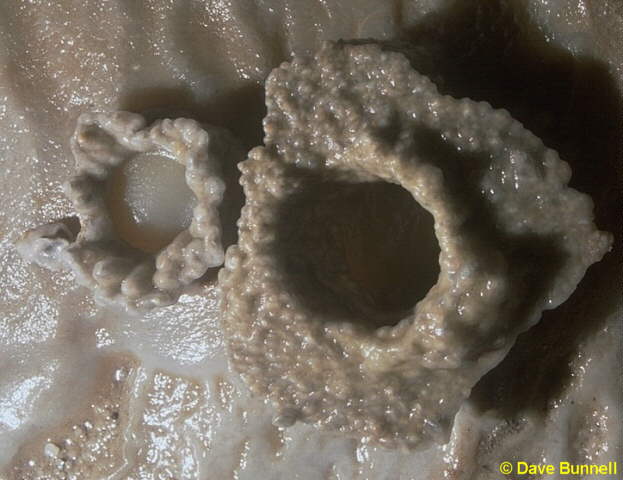
|
Conulites are the "splash cups" that form on certain cave floors beneath energetic ceiling drip sites.
When ceiling drops crash down onto poorly consolidated cave sediment, such as the sand bank underlying
the flowstone in this photo, sediment grains may be flung far and wide. These grains carry with them
surface films of the ceiling drip solution. As these solution films degas carbon dioxide, they precipitate
calcium carbonate, which serves as a sort of glue for the displaced mineral grains. Over time, repeated drips
in one location may form a tiny calcified impact crater, or conulite, complete with its own
ejecta blanket.
Eventually, the central impact cup of a conulite may, itself, become cemented with calcium carbonate. When sediment grains are no longer available for transport, the conulite can grow no deeper, though it may grow taller, as splash water continues to distribute calcite around the "ejecta blanket". The destiny of many conulites, however, will be for calcite to continue to build up within the sealed impact cup. The more the cup is filled, the faster its solution will degas, and the faster the cup can be filled! Many conulites, then, are the nesting sites of stalagmites, such as that just hatching in the conulite at left. Still, as cave formations go conulites are relatively rare. At the bottom, a much larger and one-of-a-kind conulite on a stalagmite top. Here, what may have happened is that a stalagmite became buried in sediments as floodwaters reached a low spot or sump in the cave. Calcite-laden dripwaters blasted away sediments from the top of the stal and "froze" them inside a coating of calcite.? |
![]()


![]()
| Back to: | |
 |
Created: June 19, 1995 Last Updated: November 16, 2010 Authors: Djuna Bewley and Dave Bunnell |